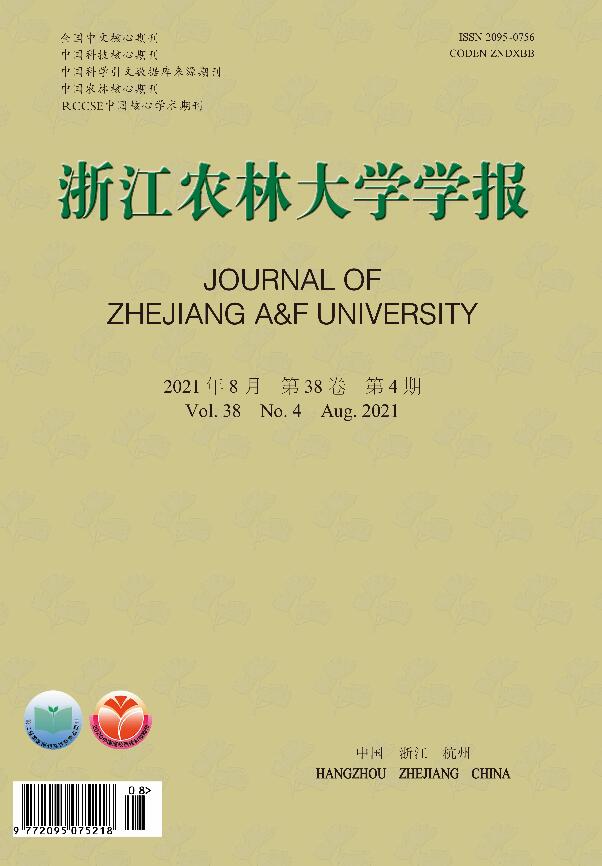-
黄檀属Dalbergia为豆科Leguminosae蝶形花亚科Papilionoideae下重要的一个属。中国黄檀属有28种1变种,产自中国西南部、南部至中部。该属包括了众多优良的材用树种,如降香黄檀D. odorifera和有着较高经济价值的紫胶虫Laccifer lacca寄主树种钝叶黄檀D. obtusifolia[1]。黄檀属乔木树种在经济上的巨大价值,导致其长期遭受盗伐与过度采伐[2]。同时由于分布区内土地的大规模开发与紫胶生产等的过度利用,黄檀属乔木在中国的自然分布区正在不断缩小,一些树种甚至濒临灭绝,许多自然分布的地理种源也即将消失。《中国生物多样性红色名录(高等植物卷)》对黄檀属植物进行了全面的评估,结果表明:黄檀属乔木树种有7种受到了不同程度的威胁,1种极危、2种濒危、2种易危、2种近危,其中钝叶黄檀濒危,而降香黄檀则极危[3]。因此,保护现有黄檀属乔木的栖息地,同时为其寻找潜在分布区进行引种和抚育有着重要生态学意义与经济价值。物种的分布受到土壤、地形等多种环境因素的制约[4-5],但气候因素可能是决定区域尺度上植物地理分布的主要环境因素[6]。全球气候变化已成为全球生物多样性面临的主要威胁之一[7]。气候变化将对全球物种的分布带来深远的影响,政府间气候变化专门委员会(IPCC)的第6次耦合模型比对项目(CMIP6)指出,在除最低排放情景外的所有排放情景中,全球平均温度都将至少上升1 ℃,且厄尔尼诺等异常天气现象将比以前大大增多[8]。据估计,受此影响,全球有20%~30%的物种可能会由于全球变暖而灭绝[9]。黄檀属乔木树种主要分布于中国的南方地区,气候变化带来的水热条件的改变则会导致黄檀属乔木适宜分布区的变更,它们较为狭窄的分布范围可能预示着对栖息地环境因子更为严格的要求[10],进而在未来气候变化的背景下可能有着更高的灭绝风险。本研究通过地理信息系统(GIS)技术和最大熵(MaxEnt)物种分布模型研究黄檀属珍稀乔木树种的分布适宜区,并通过CMIP6未来气候数据得出未来气候背景下的适宜分布区,找出影响黄檀属珍稀乔木树种的主要环境因子,得出黄檀属珍稀乔木树种分布适宜区的变化趋势,以期为应对未来气候变化下的珍稀树种保护区调整和生态安全建设提供依据。
HTML
-
从《中国生物多样性红色名录(高等植物卷)》筛选出了全部7种受威胁的黄檀属乔木树种作为珍稀乔木树种进行研究。根据中国数字植物标本馆(CVH, http://www.cvh.ac.cn/)、全球生物多样性信息服务网络平台(GBIF, https://www.gbif.org/)、中国期刊全文数据库(https://www.cnki.net/)及国家标本资源共享平台(http://www.nsii.org.cn/)搜集了相关树种的当前分布坐标数据。
为了全面评估物种分布受到的环境因素影响,本研究选取了19个气候数据、15个土壤数据与3个地形数据作为环境因子参与模型运算。气候数据来源于世界气候网(http://www.worldclim.org/),数据空间分辨率为1 km,共有19个气候因子(表1)。使用1970−2000年19个气候因子的平均值作为当前气候建模数据(表2),未来气候数据为CMIP6发布的2061−2080年的平均气候数据,该数据可以更准确地展示在未来气候长期影响下的响应[11]。本研究选取中国国家气象中心开发的BCC-CSM2-MR模式作为未来气候的数据源,其对中国降水与气温的模拟较为可靠[12]。气候情景则选取与当前经济社会发展相符合的中等温室气体排放情景(SSPs 245, Shared Socioeconomic Pathways 245),该模式情景与目前排放趋势相对应,具有较高的准确性[13]。
编号 环境因子 编号 环境因子 bio1 年平均温度 GRA 碎石体积百分比 bio2 平均日温差 Sand 含沙量 bio3 等温性 Silt 淤泥含量 bio4 温度季节变化系数 Clay 黏土含量 bio5 最热月最高温度 USDA_Tex 土壤质地 bio6 最冷月最低温度 OC 有机碳含量 bio7 气温年较差 pH_H2O 酸碱度 bio8 最湿季平均温度 CEC_Clay 黏性层土壤阳离子交换能力 bio9 最干季平均温度 CEC_Soil 阳离子交换能力 bio10 最热季平均温度 BS 基本饱和度 bio11 最冷季平均温度 CaCO3 碳酸盐含量 bio12 年平均降水量 ESP 表层土壤可交换钠离子 bio13 最湿月降水量 ECE 表层土壤电导率 bio14 最干月降水量 TEB 可交换性盐基 bio15 降水量季节变化 BD 土壤容重 bio16 最湿季降水量 ALT 海拔 bio17 最干季降水量 SLO 坡度 bio18 最热季降水量 ASP 坡向 bio19 最冷季降水量 Table 1. Environment factors and their codes
环境因子 各因子在模型计算中的贡献占比/% 总贡献率/% 秧青 毛叶黄檀 多体蕊黄檀 降香黄檀 钝叶黄檀 黄檀 海南黄檀 bio1 5.1 0 0.2 83.6 23.4 1.4 0.8 16.47 bio2 0.7 3.8 0.5 0 0 3.5 0.4 1.28 bio3 6.1 41.2 0.1 0.7 22.7 1.2 3.3 10.83 bio4 25.2 0.9 49.9 0 35.6 1.8 2.7 16.70 bio5 2.6 0 0.1 0 0 0.6 0 0.47 bio6 0 0 0 3.4 4 1.7 3.4 1.80 bio7 0 0 5.2 0 0 3.4 0 1.24 bio8 2.9 0 1.3 0 0 0.8 0 0.72 bio9 0.2 0.1 0 2.9 2.6 0.1 3.3 1.32 bio10 0 0 0 0.3 0 1.5 0 0.26 bio11 0.1 0 0 0 0.8 0.3 85.6 12.49 bio12 0 0 1.6 0 0.2 5.4 0 1.04 bio13 0 0 0 0.7 0 0.1 0 0.12 bio14 2.4 1.9 0.2 0 0 53.4 0 8.33 bio15 0 0.1 5.7 0.2 0.1 1.9 0 1.15 bio16 8.5 0 0 0.1 0 0 0 1.24 bio17 32.6 0 9.2 0 0 2.0 0 6.30 bio18 0.6 9.7 5.8 3.7 0 0.3 0 2.89 bio19 0 0 1.0 0 0.7 2.2 0 0.56 USDA_Tex 0.2 5.4 0 0 0 0.2 0 0.83 CaCO3 2.5 12.2 0 0 0.7 1.3 0 2.40 Silt 1.0 3.5 0 0.8 0 0.9 0 0.89 TEB 0.8 0 0 0 0 3.0 0 0.55 Sand 0 0.3 0 0.8 0 0 0 0.16 Clay 0.1 0.4 0.2 0.1 0 0.8 0 0.23 CEC_Soil 0.1 0 0 0.9 1.8 0.1 0 0.42 CEC_Clay 0 0 6.5 0.5 1.5 1.0 0 1.37 BS 0 0 3.8 0 0 0.2 0 0.58 BD 0 1.7 0 0 0 0 0 0.24 ECE 0 0 0 0 0 0 0 0.00 ESP 0 3.8 0.5 0 0 0.2 0 0.65 GRA 0 0 2.2 0 0.6 0.5 0.4 0.53 OC 0 0 0 0 0 0 0 0.00 pH_H2O 0 0 0 0 0 0.3 0 0.04 ALT 0 0 3.6 1.2 0.1 2.1 0 1.01 SLO 3.3 15.1 1.9 0 4.7 4.2 0 4.20 ASP 0.3 0 0.8 0.1 0.4 3.3 0 0.70 说明:加粗值为关键因子。秧青D. assamica,毛叶黄檀D. sericea,多体蕊黄檀D. polyadelpha,海南黄檀D. hainanensis Table 2. Distribution of rare tree species of Dalbergia in modeling
土壤数据来源于中国科学院寒区旱区科学数据中心(http://westdc.westgis.ac.cn),是南京土壤研究所基于第2次全国土地调查所提供的1∶100万土壤数据制作,栅格大小约为1 km,共有15个指标(表1)。坡度、海拔与坡向数据来源于中国科学院计算机网络信息中心国际科学数据镜像网站(http://www.gscloud.cn)提供的数字高程模型(DEM),空间分辨率为90 m,利用ArcGIS(版本10.2,www.esri.com)的表面分析工具提取得到地形数据(表1)。这些环境因子数据坐标统一为WGS1984,分辨率重采样为30"。气候数据与土壤地形数据按照研究区裁剪。同时,模型运算时使用中国科学院资源环境数据中心(http://www.resdc.cn)中国地理数据对气候图层进行掩膜裁剪后作为底图进行处理。
-
物种地理分布的预测模型在生态学和自然保护等领域得到了广泛应用,可用于分析物种潜在分布区并预测其未来分布[14-15]。其中最大熵模型是PHILLIPS等[16-17]开发用于模拟给定环境条件下物种出现概率的物种分布模型。其原理是根据物种所有已知分布点的环境变量建立多种分布函数,从中选取熵值最大者,进而计算其在整个预测范围内的潜在分布情况[18]。模型采用受试者工作特征曲线(ROC曲线)下的面积(AUC, the area under the ROC curve)检验模型模拟效果[19-20]。与其他物种分布模型对比,如GARP、ENFA和BIOCLIM等,MaxEnt模型的AUC值更高,即预测结果更优,因此本研究使用该模型进行物种分布模拟[21-23]。
依据PHILLIPS等[17]对模型预测精度判断标准的研究,当受试者工作特征曲线中AUC值大于0.9时说明预测效果极好,预测结果精度高。本研究设置75%数据用于构建模型,25%的数据用于模型检验。根据样本训练集的AUC值及测试集的AUC值来评价模型拟合效果。通过模型提供的刀切法(jackknife)得出因子百分贡献率,以考察各环境因子对于模型的贡献率及重要性,得出各因子贡献率排序以筛选关键环境因子,并依据关键因子对物种的适宜分布区进行再次预测。MaxEnt模型以栅格形式输出物种的生境适宜度(P),模型采用最大训练敏感性和特异性(maximum training sensitivity plus specificity,MaxSS)方法确定P的阈值,每个物种在运用最大熵模型训练完成后系统会给出相应的MaxSS值。基于IPCC制定的划分标准[24-26],研究区黄檀属珍稀乔木的适生等级可划分为3类:P<MaxSS阈值的区域为非适宜分布区;MaxSS阈值≤P<0.66的区域为较适宜分布区;P≥0.66的区域为高适宜分布区。
1.1. 物种分布数据与影响因子
1.2. 物种分布模型
-
基于黄檀属珍稀乔木树种实际分布数据和包括气候、土壤与地形在内的37个影响因子,使用MaxEnt模型进行建模,模拟当前适宜分布区并预测未来适宜分布区。结果显示:经过模型运行10次迭代后最大熵模型的模拟效果极好,采用受试者工作特征曲线分析模型的预测衡量指标,其训练集与测试集AUC 值均高于0.95,表明MaxEnt模型预测可信度较高,可用于黄檀属珍稀乔木树种适宜分布区变化的研究。
-
本研究通过MaxEnt模型的刀切法获得了各环境因子对7种黄檀属珍稀乔木适宜区分布模拟的贡献率及全模型总贡献率,并筛选了影响黄檀属珍稀乔木分布的关键环境因子(表2,加粗值为关键因子)。37个环境因子中,年平均温度、等温性、温度季节变化系数、最热季降水量、最干月降水量、最干季降水量、土壤碳酸盐与坡度在7种植物中均有超过10%的贡献占比,且它们的总贡献率占到了全模型贡献率的77.72%,因此它们是影响7种黄檀属珍稀乔木适宜区分布模拟的关键环境因子。
研究结果表明:秧青的分布主要受温度季节变化系数与最干季降水量的影响,贡献率分别为25.2%和32.6%。毛叶黄檀主要受等温性、土壤碳酸盐与坡度的影响,贡献率分别为41.2%、12.2%和15.1%。多体蕊黄檀则主要受温度季节变化系数的影响,贡献率为49.9%。钝叶黄檀的主要影响因子为年平均温度、等温性和温度季节变化系数,贡献率分别为23.4%、22.7%和35.6%。主导降香黄檀分布的环境因子为年平均温度,其贡献值为83.6%。黄檀的分布主要受最干月降水量的影响,贡献率为53.4%。海南黄檀主要受最冷季平均温度的影响,贡献率为85.6%。
-
根据物种分布适宜区的划分标准,得到黄檀属珍稀乔木在当前气候下分布适宜区的分布面积的变化数据(表3)。秧青在云南南部、海南、广东、福建和广西有较大的适宜分布区,最适分布区为云南南部与海南南部,适宜分布区域面积为43.35×104 km2,最适分布区面积为6.04×104 km2。海南黄檀仅分布在海南南部沿海区域,适宜分布区面积为0.20×104 km2,最适分布区面积为0.03×104 km2。黄檀为华南广布树种,其适宜分布区面积高达114.18×104 km2,最适分布区面积为10.12×104 km2。钝叶黄檀以海南和云南南部为主要分布地,在中国台湾西部也有适宜分布区,其适宜分布面积为29.54×104 km2,最适分布区面积为4.60×104 km2。降香黄檀为极度濒危的物种,主要分布在海南与广东,在海南与云南西双版纳有小范围最适分布区,该种适宜分布区面积为25.64×104 km2,最适分布区面积仅为1.06×104 km2。多体蕊黄檀仅分布在云南及其接壤的周边区域和西藏南部地区,其适宜分布区面积为31.2×104 km2,最适分布区面积为3.75×104 km2。毛叶黄檀主要分布在西藏南部地区及云南和四川的高原山地之中,其适宜分布面积为17.54×104 km2,最适分布区面积为4.91×104 km2。
种名 濒危等级 生境适宜度阈值 样点数 不同时期适宜分布区面积/万km2 不同时期最适分布区面积/万km2 当前 未来 当前 未来 秧青 濒危 0.287 55 43.35 64.95 6.04 12.06 海南黄檀 易危 0.335 10 0.20 1.15 0.03 0.08 黄檀 近危 0.273 201 114.18 79.03 10.12 5.09 钝叶黄檀 濒危 0.175 19 29.54 44.17 4.60 8.58 降香黄檀 极危 0.134 15 25.64 77.64 1.06 15.99 多体蕊黄檀 易危 0.253 25 31.20 51.15 3.75 14.26 毛叶黄檀 近危 0.386 10 17.54 51.45 4.91 29.10 Table 3. Suitable distribution area of 7 rare tree species of Dalbergia and their records numbers
-
本研究选取未来气候情景(2061−2080年)SSPs 245稳定气候情景模式下黄檀属珍稀乔木的分布范围和面积,并进行了分析。结果显示:除黄檀适宜分布区与最适分布区均有所减少外,其余6种黄檀属珍稀乔木在SSPs 245未来气候情景下适生区面积均呈增加趋势,其适宜分布区质心也均有向北扩展的趋势。秧青未来适宜分布区面积增加了49.8%,在福建西部有了更大面积的适宜生境;海南黄檀未来适宜区面积增加至1.15×104 km2,分布范围也由海南扩张至中国台湾南部,其最适分布区则由0.03×104 km2增加至0.08×104 km2,且在台湾南部出现了最适分布区。钝叶黄檀在SSPs 245气候情景下适宜生境面积增加了49.5%,达到44.17×104 km2,其适宜分布区与最适分布区在云南均大大增加,适宜分布区拓展至四川攀枝花一线,同时适宜分布区质心与最适分布区质心均向北延伸。多体蕊黄檀未来适宜区面积增长为51.15×104 km2,最适分布区面积增长为14.26×104 km2,分布边界不断向云南东部延伸,在贵州、广西、云南的交界处黔西南、百色、文山等地区出现了适宜生境。黄檀的适宜分布区与最适分布区则有所减少,适宜分布区面积减少了30.8%,缩小至79.03×104 km2,最适分布区面积减小了49.3%,缩小至5.09×104 km2,在山东南部沿海出现了一定的适宜分布区,但贵州、广西、广东和福建的当前适宜分布区均在未来大幅度收缩。
在2061−2080 年未来气候变化情景下,降香黄檀、毛叶黄檀在SSPs 245情景下适生区面积将会有较大提升。其中,降香黄檀的适宜分布区面积由原先的25.64×104 km2增长为77.64×104 km2,最适分布区则由1.06×104 km2增加至15.99×104 km2,适宜分布区由原先的海南岛与雷州半岛迅速向北延伸至广东、广西、江西和福建等地,同时在广东与广西也出现了大范围的最适分布区。毛叶黄檀的适宜区面积由原先的17.54×104 km2增长为51.45×104 km2,最适分布区由4.91×104 km2增加至29.1×104 km2,在SSPs 245气候情景下,适宜分布范围将大大北移,覆盖云南全境、四川西部及西藏南部。
2.1. 模型适用性分析
2.2. 影响黄檀属珍稀乔木分布的主导环境因子
2.3. 黄檀属珍稀乔木的适宜分布区
2.3.1. 当前气候下适宜分布区分析
2.3.2. 未来气候下适宜分布区预测
-
根据MaxEnt模型运行的结果,黄檀的适宜分布区与最适分布区均有所缩小,秧青、海南黄檀、钝叶黄檀、降香黄檀、多体蕊黄檀、毛叶黄檀等6种黄檀属珍稀乔木适宜分布区与最适分布区在中等温室气体排放情景下有所扩大,其中降香黄檀与毛叶黄檀的适宜区将会由原先的单一省份及周边的小范围分布转为覆盖多个省份的较大范围分布。物种分布模型得出的关键因子均值可以较好地反映物种对环境的适宜范围[27]。研究发现:7种黄檀属珍稀乔木均有相应的关键环境因子及其均值,其中秧青适生区温度季节变化系数的均值为852,最干季降水量的均值为390 mm;毛叶黄檀适生区等温性均值为43.1,土壤碳酸盐含量的均值为8.7%,坡度均值为21.3°;多体蕊黄檀适生区气温季节变化系数均值为632;降香黄檀适生区年平均气温的均值为21.4 ℃;钝叶黄檀适生区年平均气温均值为13.6 ℃,等温性的均值为38.8,温度季节变化系数的均值为494;黄檀适生区年最干月降水量均值为39 mm;海南黄檀适生区最冷季平均气温均值为20.8 ℃。该结果对黄檀属珍稀乔木资源的保护、造林区规划以及可持续经营等具有一定指导意义。
-
本研究中,7种黄檀属珍稀乔木中仅有黄檀一种为南方大范围分布的树种,同时也仅有黄檀一种的适宜分布区与最适分布区有所缩小。原因与其对最干月降水量的敏感程度有关,黄檀的分布主要受最干月降水量的影响,贡献率为53.4%,其适宜的最干月降水量为2~76 mm,因此最干季节过高的降水量会对黄檀的分布造成不利影响。在中等温室气体排放情景中,由于全球气候变化,南方地区在未来各个气候情景中都会更加潮湿,未来最干月降水量普遍增加,导致黄檀在贵州、广西、广东和福建的适宜分布区均大幅度收缩。这意味着当地对黄檀的抚育及引种工作应当有所调整,而江西等纬度更高的省份则应当在黄檀的保护中处于更加优先的地位。
作为亚热带常绿树种,黄檀属珍稀乔木在未来普遍获得了更大的适宜分布区。植物地理分布是多种因素综合作用的结果,每一物种均有决定其物种分布范围的关键因子,物种的分布面积随关键因子的变化而变化[28],其中气候被认为是影响植物分布大尺度格局的主要因素[29]。全球气候的变化可能带来温度年较差的扩大与干湿两季降水量的不平衡,进而对植物生长造成影响[30]。秧青、钝叶黄檀与多体蕊黄檀则均对季节温差变化有着较高要求,而温度季节变化系数在中等温室气体排放情景下并无显著变化,这些可能是上述4种黄檀属珍稀乔木分布区并没有大幅扩张至其他省份的主要因素。毛叶黄檀对温度季节变化的要求较为宽松,对土壤碳酸钙的要求适中,且受坡度的限制较小;降香黄檀的适宜区分布则主要由年平均温度决定。随着全球气候变化,南方区域气温与降水量均有所增加,这些限制因素逐渐减少,因此它们的适宜分布区面积获得了更大的扩张与显著的北移[31]。
-
黄檀属乔木树种作为中国重要的材用树种与紫胶虫寄主树种,有着十分重要的经济价值。随着近自然森林经营等先进营林措施的不断推广,目前在纯林中混合种植黄檀属珍稀材用树种的营林措施正在受到重视,因此研究黄檀属珍稀乔木的适宜分布区及其对气候变化的响应显得尤其重要[32]。对于传统紫胶虫寄主树种钝叶黄檀,其种植范围当前仅局限于云南南部普洱等地,因此紫胶虫产业也受到寄主树种规模的限制而难以进一步扩大。本研究发现:钝叶黄檀当前在海南有着较好的适宜分布区,未来其适宜区将会拓展至普洱北部的临沧一带,因此在海南与云南中部乃至更北的区域引种钝叶黄檀,改良当地林分结构,增加经营收入有着重要的理论支撑。同时,秧青作为濒危物种,其实际分布区域碎片化严重,但其适宜分布区则从广西南部延伸至云南南部,其种群恢复潜力较大,应当在引种与造林规划中给予优先考虑[33]。海南黄檀是中国珍稀的材用树种,当前已被列入易危物种;随着全球气候的变化海南黄檀适宜分布区有所增加,但是依然局限于海南南部沿海地区,因此应当在未来的物种保护工作中将海南黄檀优先级适当提高[34]。随着全球气候变化,降香黄檀的适宜分布区将会向北延伸至广西与广东境内,应当在“两广”地区推广引种[35]。
-
研究所用物种的地理分布数据受到地形和交通等条件的限制,标本记录的采样点多集中于道路附近和自然保护区等特殊区域[36]。这些采样点通常不代表环境梯度的随机样本,因而许多物种的实际分布信息不完整,可能影响模拟结果[37]。同时,物种的分布及其灭绝风险还受到物种本身的性状、当地地质条件和人为活动等多方面的综合影响,因此后续的研究可综合多种非生物与生物因子进行,以期获得更加准确的预测结果[38]。MaxEnt模型尽管精度较高,解释性良好,但目前遗传模型与随机森林模型等在物种分布预测上的应用越来越广泛,因此采用多模型对物种进行评估也有着重要的现实意义[39]。后续研究可以立足于有着重大价值的珍稀濒危物种,结合多模型、多因素进行模拟,以期得出珍稀濒危物种在气候变化背景下中国适宜区的变迁趋势,并结合提出更全面的保护手段。









 DownLoad:
DownLoad: